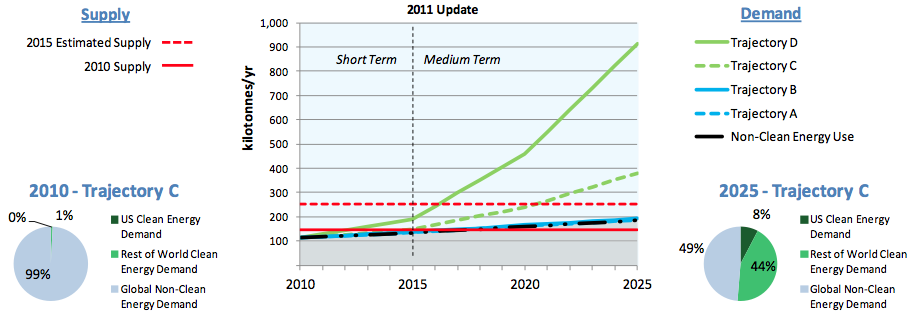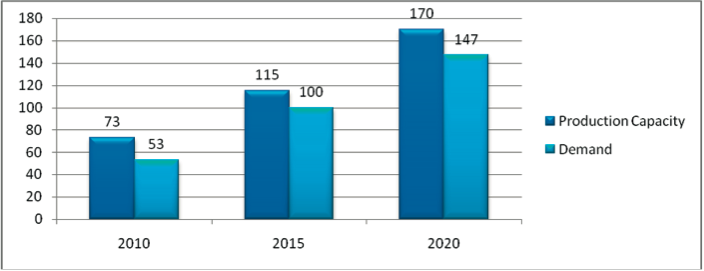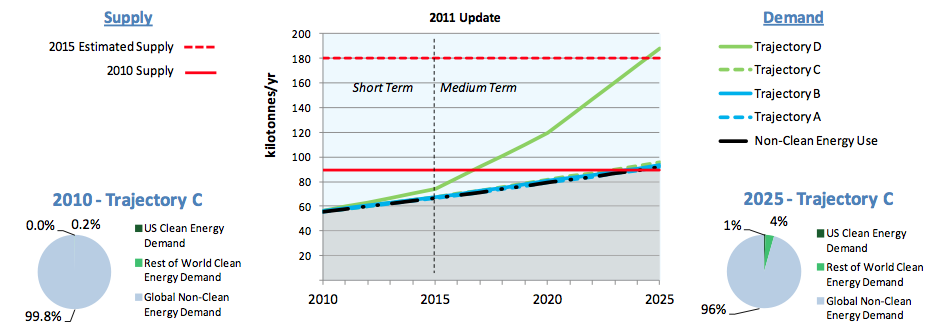Supply of these elements currently meets demand. In fact, supply-demand equality is predicted by most sources to continue for the near future. However, as demand increases due to population growth and further development of technologies that rely on these elements, it is likely that supplies will become strained for many elements.
Cobalt, Niobium, and Tantalum:
The world is not expected to run out of cobalt for much of the foreseeable future. Rather than being limited by physical sources of cobalt, the restraint upon world supply depends and will continue to depend upon the political climate of the countries in which it is produced (Department of Energy, 2011).
Prediction for Supply and Demand of Cobalt, Using Multiple Clean Energy Implementation Scenarios

Source: Department of Energy, 2011
Similarly, niobium and tantalum supplies are not expected to run out, because while Brazil produces far more coltan than the Congo, the reserves in the Congo, 80% of the world's coltan, could meet the entire world need if they were mined (Papp, 2011). Supply is not likely to be an issue even on a 100 year timescale, however, due to the volatile political climate of the Congo and surrounding countries, prices have been fluctuating wildly enough to concern manufacturers.
Predictions for Supply and Demand of Niobium (in kt)

Source: Moss, Tzimas,Kara, Willis, & Kooroshy, 2011
Lithium:
Over half of the world's lithium supply comes from the brines in Northern Chile.
As hybrid cars become more and more popular, the demand for lithium will increase due to lithium's critical role in the production of lightweight, efficient batteries. It is in the interest of electric car companies and industries creating these new technologies to promote the belief that lithium is in plentiful supply and will continue to be over the next 100 years, however some these reports exaggerate resources and overestimate the abilities of rising new technologies to replace lithium components with other more abundant elements (Evans, 2009). Thus, the future of lithium supply is not as plentiful as it would seem. Future supply levels are expected to be above or at future demand for the next four years. However, starting in late 2016, early 2017, lithium demand will grow much more than supply. Thus, new sources of supply and ways to reduce demand will need to be found for lithium.
Prediction for Supply and Demand of Lithium, Using Multiple Clean Energy Implementation Scenarios:

Source: Department of Energy, 2011
Zirconium:
Zirconium prices have also seen significant instability over the past five years because of fluctuating demand, which recently increased due to an increase in zirconium's use in ceramics and chemicals, over half of which are consumed by China. Suppliers are struggling to meet this increased demand as zirconium has usually been mined as a byproduct of titanium extraction. Its production has therefore been constrained by titanium demand. Along with current increases in demand, as nuclear energy rises in the world the demand for zirconium is expected to increase as well ("Supply Shortage," 2011).
Evans, K. (2009, August 27). The future of electric vehicles: Setting the record straight on lithium availability. Retrieved from http://www.ensec.org/index.php?option=com_content&view=article&id=213:the-future-of-electric-vehicles-setting-the-record-straight-on-lithium-availability&catid=98:issuecontent0809&Itemid=349
Moss, R. L., Tzimas, E., Kara, H., Willis, P., & Kooroshy, J. (2011). Critical metals in strategic energy technologies. JRC scientific and technical reports, doi: JRC 65592. Retrieved from http://setis.ec.europa.eu/newsroom-items-folder/jrc-report-on-criticalmetals-in-strategic-energy-technologies/at_download/Document
Papp, J. F. (2011). Retrieved from http://minerals.usgs.gov/minerals/pubs/commodity/niobium/myb1-2009-niobi.pdf
Supply shortage of zircon to continue, further price rises unsustainable. (2011, June 16). Retrieved from http://www.prnewswire.com/news-releases/supply-shortage-of-zircon-to-continue-further-price-rises-unsustainable-124015944.html
U.S. Department of Energy. (2011, December). Critical materials strategy. Retrieved from http://energy.gov/sites/prod/files/DOE_CMS2011_FINAL_Full.pdf

